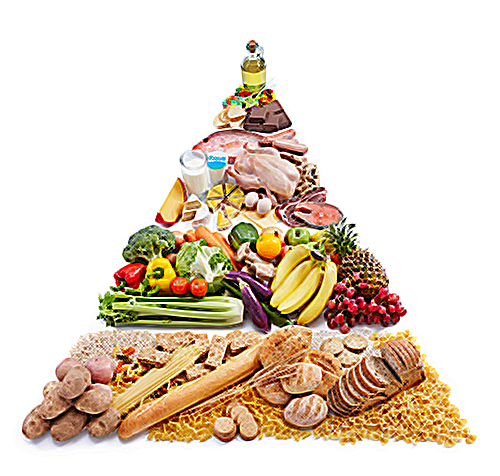Contents
Throughout life, humans are responsible for choosing the right foods. Depending on how these food products are utilized, the result may be:
- Improved health, avoiding and even curing disease. On the other hand,
- Deteriorated health, disorders, and suffering.
Unfortunately, the way food is used very frequently bears negative health consequences. Because of this, the eminent Spanish physician Gregorio Marañón is quoted as saying, “Each day we are digging our own graves with knife and fork.”
However, there is no reason for this to be so. There must be a proper way to use food products to convert them into a health and well-being source. It runs counter to natural logic to think that eating foods essential for sustaining life inevitably leads to disease. Proper use of foods as described below requires that they be:
- Chosen wisely, according to the healthful foods pyramid
- Combined correctly and adequately balanced,
- Well distributed throughout the day,
- Prepared and cooked appropriately, and
- Enjoyed with pleasure within the framework of a healthy lifestyle.
The knowledge of foods on this website should aid the visitor in using them properly to benefit health.

Choosing The Right Foods
When someone sits down in a restaurant, the first thing they usually do is study the menu to select a meal. Choosing what to eat takes place in the supermarket or the kitchen at home.
Eating is a choice
Eating is, before anything else, a choice. You only fail to choose food when circumstances force you, and you have no choice. Social customs, tastes acquired, variety, and economic resources influence food choices. However, despite all this, it is still an act of free will.
The Role of Appetite in Selecting Foods
Of course, individual tastes are essential and play a significant role in the selection of foods and digestive physiology. However, the appetite is often jaded due to an artificial and unhealthy lifestyle. This creates a desire for products that do not meet the body’s physiological needs or, worse, are harmful to health.

Because of this, the appetite is not a reliable guide in choosing foods, mainly if it has not been oriented toward health. Eating only what one likes presents a severe health risk. The appetite center, which resides in the diencephalon, must be controlled by reason, and the will resides in the cerebral cortex. This outer layer of the brain is accountable for higher brain function in humans.
Orienting the appetite toward healthful foods is a process that may be somewhat uncomfortable at first. But the ultimate benefit is worth the effort. Ideally, this process should begin at birth, but it is never too late. A study of the properties of foods and an understanding of their healing power, beginning in childhood, helps with this orientation.
Only with accurate information and a correctly oriented appetite can a person make wise food choices that lead to health and well-being.
How to Choose Foods
Foods must meet the following four conditions:

1. They must meet nutritional needs: The foods chosen must meet individual dietary needs, which vary with age, weight, and other personal circumstances.
2. They must be healthful: A hamburger, French fries, and ice cream, for example, may meet nutritional needs. However, they are not healthy foods. Although humans can eat various foods, they are not all equally suited for human consumption. As has been throughout this website, it is a fact that there are:
– Foods with benefits outweigh the drawbacks, and others are the opposite.
– Foods with healing powers and others that promote certain diseases.
– Healthful foods and harmful foods.
Unfortunately, some nutrition specialists advocate a diet that includes “a little of everything” and that a balanced diet is one in which one eats a little of what is good, a little of what is not so good, and a little of that which is downright harmful. This is an undemanding, comfortable position, but one so good, and a little of that which is downright detrimental.
The proper use of foods is to choose only those that are healthful and abstain from all those that pose a health risk.
3. They must prevent disease – Food products can have the opposite effect, depending on their chosen choice: they can cause or prevent illness. All plant-based foods described on this website have preventative and healing power. Those with preventive capacity are remarkable for:

– Their antioxidant content (primarily provitamin A and vitamins C and E), and
– Those that contain phytochemicals, many of which are natural coloring.
Fresh vegetables and fruits meet both requirements and have the most significant potential for preventing and even curing diseases. Because of this, they are considered medicinal foods. Their active ingredients and effects are like those of medicinal plants.
Proper food use also involves correctly choosing plant-based foods that inhibit the diseases to which one is most exposed due to environmental or hereditary factors.
4. They must avoid the problems of the modern diet: Understanding these problems facilitates the selection of foods that prevent them.
Combine Foods the Right Way
No single food provides all the human nutrients except the mother’s milk during the first months of life. Thus, combining foods is essential. Doing this correctly is not difficult since the digestive tract is prepared to digest various foods from an anatomical and physiological point of view.
The right combination:
1. Achieves a balance among the energy-producing nutrients – Foods must be combined so that a balance exists among the calories supplied by the three energy-producing nutrients: carbohydrates, fats, and proteins. Most calories should come from carbohydrates, primarily grains, legumes, and tubers. As recommended in the food pyramid, eating ample amounts of these foods makes reaching this ideal balance easy.
2. Adequately supplements proteins – There is no protein, except mother’s milk, which provides the exact proportion of amino acids humans need. The proteins in eggs are the closest to this ideal since their biological value is ninety-four percent. Meat proteins (biological value = seventy-five percent) are not as complete as some believe. They must also be complemented.
Vegetable proteins are those with the lowest biological value (except soy). But by combining two or more of them in the same meal (or within 12 hours), the body obtains all necessary amino acids in the ideal proportions. This is the phenomenon of supplementation, thanks to which mixing two vegetable proteins equals a complete protein. The following combinations provide complete proteins:
- Grains with milk or dairy products,
- Grains and legumes,
- Grains and vegetables,
- Legumes with vegetables.
3. Avoid incompatibilities – Avoiding dietary incompatibilities is simply a question of not eating excessive foods at the same meal and observing oneself determine any personal intolerance. Many doubt that food incompatibilities exist since all healthful foods are compatible. What does exist are individual intolerances, both to foods and their mixture. Mixing milk and sugar or eggs is one of the worst tolerated.
Other Ideas for Using Food Properly

Distribute them throughout the day
- Breakfast and dinner should be the most energy-producing of the day.
- For adults, supper should be either avoided or very light. In any case, it should be eaten at least two hours before bedtime.
- Do not stack between meals. This bad habit leads to obesity and increased cholesterol.
Prepare and cook them properly
- Eat raw foods whenever possible.
- Avoid overcooking foods since this destroys certain nutrients (proteins and vitamins).
- Avoid toasted, roasted, or smoked foods, particularly meat and fish, since these preparation forms entail the production of carcinogens.
Enjoy them
Proper use of foods also includes learning to enjoy them, notably the healthier they are.
Appetite and Reason
Diencephalon – This part of the brain is where food appetite and sensations of hunger and thirst are located.
Cerebral cortex – This is the anatomical seat of reason and the will. Under normal conditions, it can control the rest of the brain, including the diencephalon, where the appetite and other instinctual behaviors reside.
In the human brain, reason can and must control the appetite. The appetite or pleasure is not a reliable guide in choosing the best foods for health and well-being.
Consequences of Food Choices

The decisions that are continually being made concerning what foods to eat are transcendent acts that have varied and far-fetched consequences, particularly on:
- Long and short-term individual health.
- In the case of fathers before procreation and mothers during pregnancy and nursing, progeny health.
- Collective and individual economy
- Ecology and the environment.
Foods must provide these four groups of substances:
Energy-producing nutrients (fuel): Carbohydrates, fats, and proteins. These release energy with which the body maintains its temperature and performs chemical and physical work.
Plastic nutrients (constructive): Primarily proteins, calcium, and phosphorus. These form the structure of the body and renew and repair tissues.
Regulating nutrients (biocatalysts): vitamins and minerals. These facilitate and control the various physiological functions.
Non-nutritive components: Fiber and phytochemicals. Together with vitamins, these are responsible for foods’ preventative and healing power.
American Dietary Guidelines
The following guidelines were prepared by the Department of Health and Human Services and the Department of Agriculture of the United States. They apply from two years of age. They deserve consideration because of the preventative value they present to the inhabitants of all countries.
| Guideline | Our Comments |
| Eat a variety of foods | This variety should be chosen following the healthful food pyramid. |
| Stabilize the foods you consume with physical activity. Improve or maintain adequate weight. | Maintaining an ideal weight should be a personal objective. |
| Select a diet with lots of grain products, fruits, and vegetables. | This includes products made from whole grains, if they contain little or no fat or sugar (for example, whole grain bread and pasta). |
| Opt for a diet low in cholesterol, fat, and saturated fat. | Saturated fat and cholesterol are found mainly in whole milk, cheese, egg yolk, and meat and their derivatives. |
| Choose a diet moderate in sugars | This includes sugars added to foods and honey. |
| Select a diet low in salt and sodium. | Common salt is the primary source of sodium but not the only one. |
| If you consume alcoholic beverages, do so in moderation. | If you do not drink, do not begin. To enjoy optimal health, it is best to eliminate alcoholic beverages from the diet. Grapes or grape juice are far superior to wine in preventative effect. |
Health Foods Pyramid
The size of each section of the pyramid represents the relative quantity of each food group that should be eaten daily. The lower (closer to the base) a food group is situated, the more critical it is to a healthful diet.
Milk and dairy products:
2-3 servings a day. Counts as a serving of one cup of milk or yogurt or 1,5 ounces of natural cheese. Preferably nonfat or low-fat. These may be replaced with soymilk, almond milk, tofu, or other daily alternatives.
Vegetable oils:
2-3 tablespoons daily of olive oils.

Nuts:
One serving daily. Counts as a serving, for example
Vegetables:
3-4 servings daily. Counts as a serving, for example
- One cup of raw leafy vegetables
- Half a cup of other vegetables chopped or cooked raw.
Solid fats, sugar, and sweets:
May be used sparingly or not at all.
Protein-based foods:
2-3 servings daily. These include legumes, meat analogs, other soy derivatives (as alternatives to meat and fish), and eggs. Counts as a serving, for example:
- Two or three ounces of meat analog.
Grains and their products:
6-11 servings daily. Counts as a serving, for example:
- One slice of bread
- One ounce of ready-to-eat cereal.
- ½ cup of cooked rice, pasta, or cereal.
Fruit:
2-4 servings daily. Counts as a serving, for example:
Source of Calories in a Balanced Diet
Paraphrasing the Greek philosopher Pythagoras, we may say: “Choose the best foods. Habits will soon make a diet of these pleasurable and effortless.”
| Nutrient | Percentage of daily total (a) | Energy for a 2,000-calorie diet (a x 2,000/100=b) | Calories per gram (c) | Grams of daily nutrients for a 2,000-calorie diet (b/c=d) |
| Hydrocarbons | Sixty percent | 1200 kcal | 4 kcal/g | Three hundred grams |
| Fats | Thirty percent | 600 kcal | 9 kcal/g | Sixty-five grams |
| Proteins | Ten percent | 200 kcal | 4 kcal/g | Fifty grams |
| Total | 100 percent | 2000 kcal |
Benefits and Drawbacks of Additives
Benefits of additives:
- They improve the appearance of foods
- They prolong foods’ storage capacity, preventing spoilage, loss of nutritional value, and contamination by various microorganisms.
- Artificial sweeteners permit a reduction in sugar consumption.
Drawbacks to additives:
Additives are the hidden dark side of foods. Not all are listed on the label (if the law does not require it); scientific information regarding their safety is occasionally withheld for economic reasons. This notwithstanding, it is well known that numerous chemical or artificial additives are potentially toxic. Even without exceeding the ADI (acceptable daily intake), which is considered safe, their repeated use may cause:
- Allergies
- Headaches
- Hyperactivity and aggressive behavior, especially in children
- Digestive intolerance
- Decalcification from the bones
The cumulative effect of additives on the human body over the years is little understood, but there are well-founded suspicions that they may be a factor in cancer.
Highest Risk Additives
| E code | Substance | Use | Adverse effects |
| Colorings (E100-E199 | |||
| E102 | Tartrazine (food yellow 4) | Yellow coloring in candies, lemon soft drinks, and chewing gum | Urticaria, rhinitis, and other allergic manifestations |
| E110 | Sunset yellow (food yellow 3) | Instant soups, candies, fruit jams | Severe allergies, gastric disturbances |
| E123 | Amaranth | Red coloring is used in canned fruits, snacks, and soft drinks | Allergies |
| E124 | Cochineal Red A (food red 7) | Snacks, soft drinks, gelatins | Allergies |
| E127 | Erythrosine | Pink coloring is used in snacks, prepared desserts, and chewing gum (which contains iodine) | Hyperthyroidism, eczema |
| Preservatives (E200-E299) | |||
| E210 | Benzoic acid | Prepared sauces, beer, fruit juices, yogurt | Allergies, liver conditions |
| E211-E215 | Benzoates | Canned fish, shellfish, mayonnaise, and other sauces, desserts | Allergies, numbing sensation in the mouth |
| E220-227 | Sulfur dioxide and sulfites | Dried fruits, prepared salads (to maintain natural color), packaged dry soups, pre-fried potatoes, jams, wines | Severe allergies, particularly respiratory type; stomach irritation; interference with vitamin B1. It is a suspected carcinogen (benzoic acid and benzoates potentiate its adverse action) |
| E249-E252 | Nitrites | Cured meats, hams, sausages, cured fish | Forms carcinogenic nitrosamines; interferes with oxygen transport in the bloodstream |
| Antioxidants (E300-321) | |||
| E320 | Butylated hydroxyanisole (BHA) | Helps maintain the freshness of oils and fats: desserts, margarine, butter | Increases the lipid and cholesterol levels in the bloodstream |
| Emulsifiers, Thickeners y Stabilizers (E322-E499) | |||
| Orthophosphoric Acid and Orthophosphates E338-E343) | Soft drinks, particularly colas | Irritate the digestive tract, decalcification in children | |
| Artificial sweeteners | |||
| Flavor enhancers | |||
| E621-E625) | Glutamates | All types of preserved prepared foods; Chinese food | Headache, allergies |
Benefits and Drawbacks of Genetically Modified Foods
Benefits of genetically manipulating living organisms
- Resistance of crops such as soy, corn, and others to herbicides and disease. This is the primary objective of creating a genetically altered plant. This resistance permits potent herbicides to destroy all weeds without affecting the crop. This, together with more excellent resistance to viruses, bacteria, fungi, or disease-causing insects, increases crop yield.
- Improves the appearance, flavor, and storage capability of foods.
- Improves the composition of food products, making them more nutritious and healthful. For example, it is possible to create a strain of corn that contains more lysine (an amino acid that it lacks) or for the oil of certain plants to contain unsaturated fatty acids that benefit health.
- Increased production of milk, eggs, and meat by genetically modifying animals.
Drawbacks to genetic manipulation
Repercussions on the environment: This is the most severe drawback, primarily because of its unforeseen consequences. For example, herbicide resistance could pass from genetically modified crops to the weeds, converting them into “super weeds” that would require new, more toxic herbicides.
Repercussions on human health: Studies have found no significant problems. Genetically modified foods are digested and assimilated like those that have not been modified. All that is known is that their consumption produces:
- A higher incidence of food allergies and
- Greater risk of acquired resistance to antibiotics, such as ampicillin.
Altering the balance of nature: The transfer of genes from one species to another might be interpreted as interfering with the natural order, with grave consequences in bioethics. Currently, it is technically possible, for example, to implant some genes from a pig in a tomato seed. What would be the effect of eating such a tomato?
Is There a Remedy to Cure Hunger?
Genetically modified organisms, such as transgenic plants, permit increased food production and can solve the problem of world hunger. Thus, they are presented by the multinational corporations producing them. Meanwhile, there is the contradiction that in so-called “civilized” nations, the destruction of surplus food is authorized in the name of “market stability.”
Many firmly believe there are sufficient resources to end world hunger, even without recourse to biotechnology. Thus, the solution to malnutrition and desire worldwide is not producing transgenic soy or other foods but gaining victory over human greed. This is only possible through a profound mental and spiritual change, which leads to genuine love and solidarity.
DISCLAIMER: All content on this website is presented solely for educational and informational objectives. Do not rely on the information provided as a replacement for advice, diagnosis, or treatment from a qualified medical expert. If you are pregnant, nursing, or have any preexisting medical concerns, talk to your doctor before using any herbal or natural medicines.
REFERENCES
- George D. Pamplona-Roger, M.D. “Encyclopedia of Foods and Their Healing Power.” George D. Pamplona-Roger, M.D. Encyclopedia of Foods and Their Healing Power. Trans. Annette Melgosa. Vol. 2. Chai Wan: Editorial Safeliz, 2005. 388, 389, 390, 391, 392, 393, 399, 403. Print.
- World Health Organization. (2018). Noncommunicable diseases. Retrieved from https://www.who.int/news-room/fact-sheets/detail/noncommunicable-diseases
- Harvard T.H. Chan School of Public Health. (2021). The Nutrition Source: Vitamins and Minerals. Retrieved from https://www.hsph.harvard.edu/nutritionsource/vitamins/
- U.S. Department of Health and Human Services. (2020). Dietary Guidelines for Americans 2020-2025. Retrieved from https://www.dietaryguidelines.gov/
- American Heart Association. (2020). Dietary Fiber: Essential for a Healthy Diet. Retrieved from https://www.heart.org/en/healthy-living/healthy-eating/eat-smart/nutrition-basics/dietary-fiber
